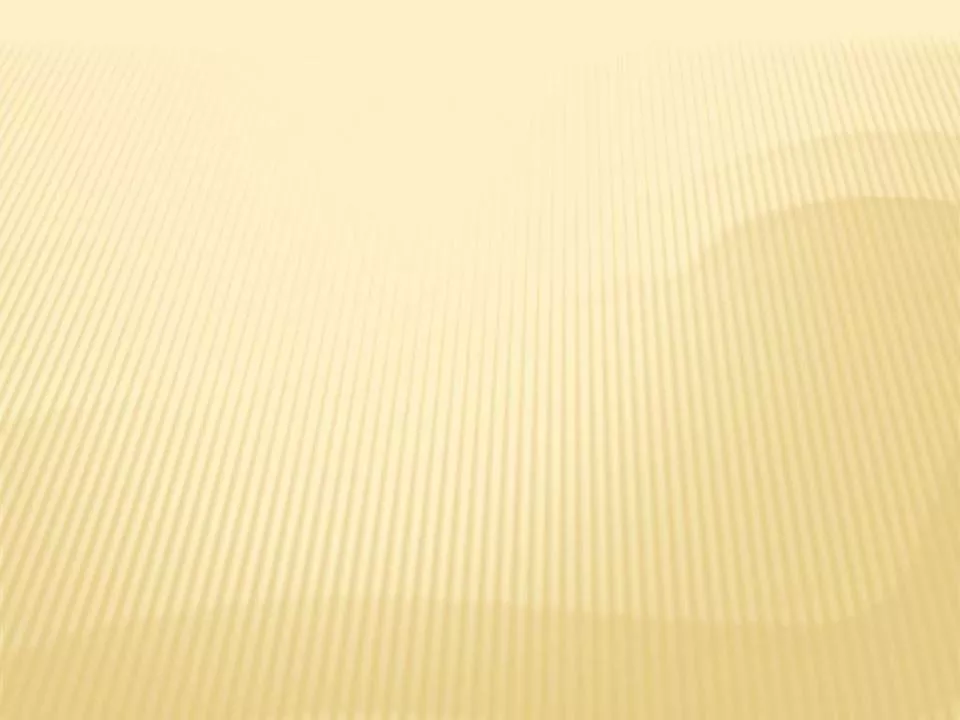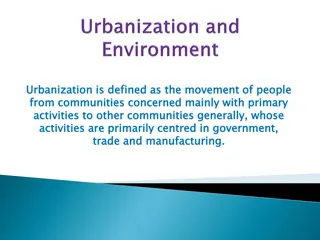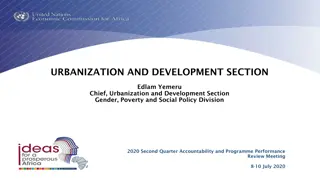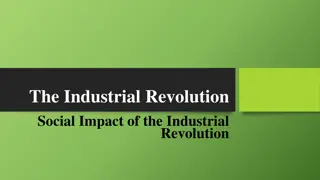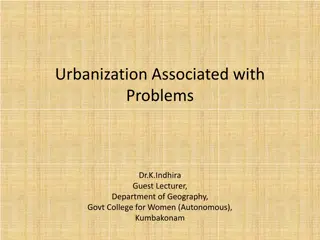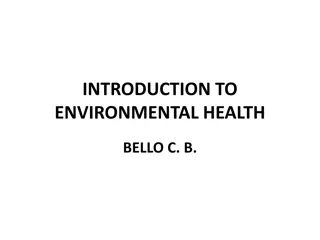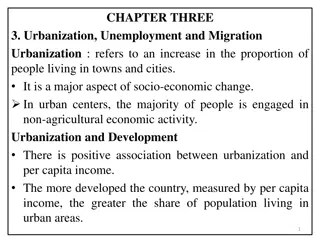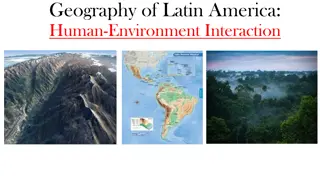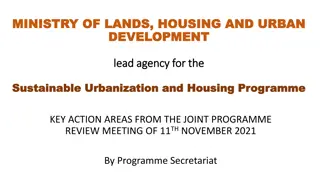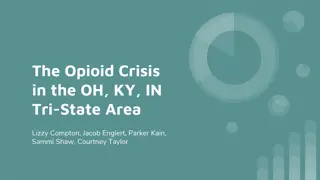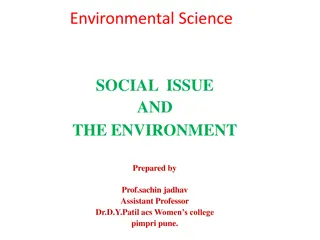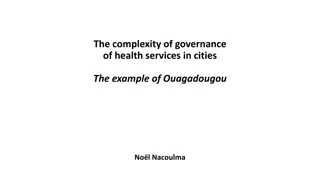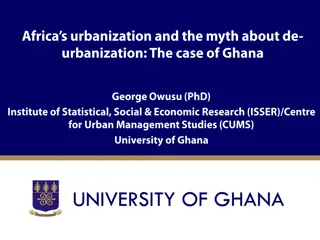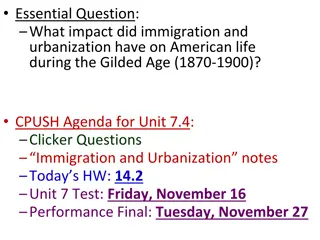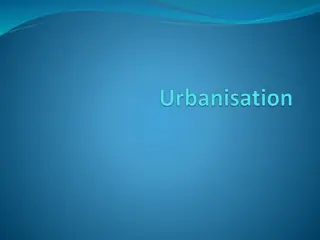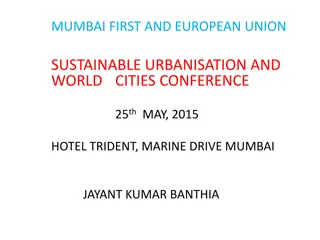The Impact of Urbanization on Health and Environment
Urbanization is a growing trend with significant implications for health and the environment. The shift towards city living is creating challenges such as pollution, lifestyle changes, and urban sprawl. The rapid increase in urban populations is projected to continue, particularly in developing nations. This urbanization trend poses both opportunities and risks that need to be addressed for sustainable development.
Download Presentation

Please find below an Image/Link to download the presentation.
The content on the website is provided AS IS for your information and personal use only. It may not be sold, licensed, or shared on other websites without obtaining consent from the author.If you encounter any issues during the download, it is possible that the publisher has removed the file from their server.
You are allowed to download the files provided on this website for personal or commercial use, subject to the condition that they are used lawfully. All files are the property of their respective owners.
The content on the website is provided AS IS for your information and personal use only. It may not be sold, licensed, or shared on other websites without obtaining consent from the author.
E N D
Presentation Transcript
URBANIZATION URBANIZATION AND HEALTH HEALTH AND
INTRODUCTION INTRODUCTION In the past, the emphasis of environmental action has often been on wilderness, wildlife, endangered species and the impact of pollution on natural landscapes outside cities. Now the focus of attenttion is to the city city environments environments. City the center of some of the most important important environmental environmental issues City dwellers dwellers areat most issues.
Urbanization is an inevitable phenomenon phenomenon that accompanies the development of a country. inevitable Worldwide are becoming an increasingly increasingly urbanized species. The rapid urbanization of the world s population over the twentieth century is described in the 2005 Revision of the UN World Urbanization Prospects report.
Urbanization is defined as the human human movement movement and centralization towards towards and and into into cities and urban cities and urban areas with the associated industrialization, urban sprawl and lifestyle that brings. the process process of and centralization of areas, Urbanization does not only involve the movement of people from rural areas but also comes about as a result of natural increases natural increases in the urban areas. rural to to urban urban
The global proportion of urban population rose dramatically from 13% (220 million) in 1900, to29% (732 million) in 1950, to 49% (3.2 billion) in 2005. It is projected that 62% of the population 62% of the population, 6.5 billion people will live in cities by 2025 6.5 billion 2025.
According to the UN State of the World Population 2007 report, the majority of people worldwide will be living in towns or cities, for the first time in history; this is referred to as the arrival of the "Urban Millennium" or the 'tipping point'. In regard to future trends, it is estimated 93% of urban growth will occur in developing nations, with 80% of urban growth occurring in Asia and Africa. It is estimated that by 2015 there will be 36 megacities (more than 8 million residents), 23 of Asia Asia. 2015 23 of them in them in
According to a new report, humans are building the equivalent of a city the size the size of of Vancouver Vancouver (shown above) everyweek. (Credit: iStockphoto/Dan Barnes)
With the growing human populations, we can imagine two futures futures. two In one liveable, use resources from outside the city in a sustainable way, minimize pollution of the country and allow room for wilderness, agriculture and forestry. one, cities are pleasing and
In the other future, cities continue to be seen as environmental environmental negatives negatives and are allowed to from the inside. to decay decay People flee them to grander and more expansive suburbs that occupy much land, and the poor who remain in the city live in an unhealthy unhealthy and and unpleasant unpleasant environment environment. poor
Although Although such inhabitants inhabitants to grow independent, independent, it it actually fragile fragile. . such a a city to grow stronger and more stronger and more actually becomes becomes more city appears appears to to its its more Ironically, Ironically, without pollute pollute even even more without care more than in the than in the past. care for for the the city, city,it past. it A city A city grows countryside, countryside, destroying surrounding destroying surrounding landscape on landscape on which it which it depends. A areas are areas are ruined ruined for for agriculture transportation transportation network extends, network extends, the misuse and misuse and destruction of destruction of the environment environment increase increase. . grows at at the the expense expense of surrounding of surrounding depends. A nearby agriculture and the nearby and the the use, use, the
THE THE CITY CITY AS AN AS AN ENVIROMENT ENVIROMENT A city changes the landscape and because it does, it also changes the relationship between biological and physical aspects of environment. A city creates an environment that is different different from surrounding areas. City change local climate; they are commonly cloudier cloudier, warmer rainier rainier than surrounding areas. warmer and
In a city, everything is concentrated, including pollutants. City dwellers are exposed kinds kinds of toxic chemicals in higher concentrations and to more human- produced noise, heat and particulates than are their rural neighbors. exposed to to more more In general, life in a city is riskier because of higher concentrations higher concentrations of pollutants and pollutant-related diseases. riskier
For example, lives are shortened by an average of one one to the most most polluted polluted cities United United States States. to two two years cities in the years in The city with greatest number of early deaths is Los Angeles, with an estimated 5, 973 early deaths per year, followed by New York with 4,024, Chicago with 3,479and Philadelphia with 2,590.
URBAN URBAN CHARACTERISTIC CHARACTERISTIC Urban area are Urban area are characterised density population density population, who are the the development development of housing schemes, housing schemes, service industries industries and and recreational characterised by , who are accomodated accomodated by of extensive extensive road roadnetworks, service and and production recreationalfacilities. facilities. by their their high high by networks, production
However, However, in rapid urbanisation, rapid urbanisation, there increases in increases in population increase in increase in pollution pollution (air and basic infrastructure basic infrastructure (health care, and and waste waste disposal). disposal). in low low and and middle middle income there are areas which are areas which large population density density, , an (air and water) water) and a (health care, water, income countries countries with with large an uncontrolled uncontrolled and a lack water, sewerage sewerage lack of of The increasing concentration of people in urban centers has strained the capacity of most governments governments to to provide provide basic slums and settlements are common. The number of people living in slums and shanty towns represent about one one- -third third of the people living in cities in developing countries. capacity of most basic services services. Illegal
In such areas, people are usually deprived access access to to the basic the basic facilities facilities of drinking water and waste disposal. Resources are not adequate for removal or disposal of waste. Residents have little access little access to make for a reasonable quality of life and human development. deprived of of to facilities facilities which
\ Thus they often suffer from greater exposure dust, unpleasant smells, chemicals and noise pollution, and the nature of dwelling makes them less able less able to withstand such hazards. greater exposure to There is direct link between people dwelling in such conditions and cholera, viral hepatitis, typhoid fever, schistomiasis, diarrhea and parasitic diseases that are carried by water or poor sanitation, overcrowding and poor diet.
These circumstances These circumstances have these areas of these areas of communicable diseases communicable diseases, , known as the as the diseases of diseases of poverty poverty including malaria, respiratory diseases, nutritional deficiency respiratory diseases, nutritional deficiency and drug drug- -related related illness. illness. have meant meant a rise a rise in in known including malaria, and
For example, in Zambia country in the African region, water-borne diseases such as cholera and dysentery are prevalent due to lack of access to clean water and bad sanitation. Zambia, the most urbanized More than half of the Mozambican population lives in unsanitary and unhealthy conditions and the levels of urban unemployment are extremely high. The unhealthy conditions are putting a huge strain on the country s health system. Mozambican urban
They are also exposed cities cities traffic, pollution etc., and suffer the consequences of social and psychological instability as the traditional support structures of rural areas steadily disappear. exposed to to health health risks risks of modern of modern Writing in the "Anatolian Journal of Psychiatry" in 2008, M. Tayfun Turan and Asli Besirli found that the social problems associated with urban societies, the traffic problems and the general anxiety about the future contributed to an increase in mental health mental health disorders disorders. increase
URBANIZATION URBANIZATION AND AND HEALTH HEALTH Urbanity Urbanity and between urban life and the living conditions affecting human health. and health health involves the connection Urbanization affects human health in several ways, from dietary dietary patterns patterns to the physical The concentration concentration of people in urban areas, with a multitude of economic economic activity activity including industrial production and extensive transportation, contributes to air pollution, which is a major health hazard. physical envir environment.
Although Although urbanization urbanization allows health health services, services, it it also poor poor parts parts of the of the cities inadequate inadequate water water and sanitation, waste waste disposal and disposal and poor air crowded crowded living conditions living conditions and allows more also creates creates health cities, , health health problems and sanitation, limited poor air quality, quality, as and general more accessibility accessibility to health hazards. hazards. In problems include limited or as well well as generalpoverty. poverty. to In include or no no as Urbanization Urbanization affects ways ways, , from from dietary environment environment. . The areas, with a areas, with a multitude of including industrial production and including industrial production and extensive transportation, transportation, contributes contributes to is a major is a major health health hazard. hazard. affects human human health dietary patterns patterns to The concentration concentration of multitude of economic health in to the the physical physical of people in urban people in urban economic activity activity extensive to air air pollution, pollution, which in several several which
In such urban areas the air, land and water are often contaminated, contaminated, spreading spreading disease the more affluent parts of the world, health hazards resulting from urbanization are mainly connected to air pollution, as well as crime, and and lifestyle lifestyle. disease. In cities in crime, traffic traffic Some problems connected to the urban physical environment affect virtually everyone, particularly air pollution. The burning of fossil fuels from transportation, industry and energy production is the main culprit regarding outdoor urban air pollution. Another health hazard common in, but not exclusive to, the cities is connected to lifestyle and consumption patterns, including dietary changes changes and and obesity obesity. dietary
CONCLUSION CONCLUSION Cities offer the lure of better employment, education, health care, and culture; and they contribute disproportionately to national economies. better However, rapid, unsustainable unsustainable patterns of urban development are making developing cities focal points for many emerging environment environment and and health health hazards rapid, unplanned and unplanned and emerging hazards.
To make cities healthy, we must, all those who deal deal with aspects with aspects of the urban urban system system that directly that directly or affect health affect health, involve themselves in urban health planning. of the or indirectly indirectly Urban planning can promote healthy behavior and safety through investment in active transport, designing areas to promote physical activity and passing regulatory control on pollution and safety.
Improving Improving urban areas of housing, water and sanitation will go a long way to to mitigate risks risks. urban living conditions living conditions in the mitigate health health Building inclusive cities that are accessible and age-friendly will benefit all urban residents. Such actions do not require additional funding, but commitment to redirect resources to priority interventions, thereby achieving greater efficiency.


